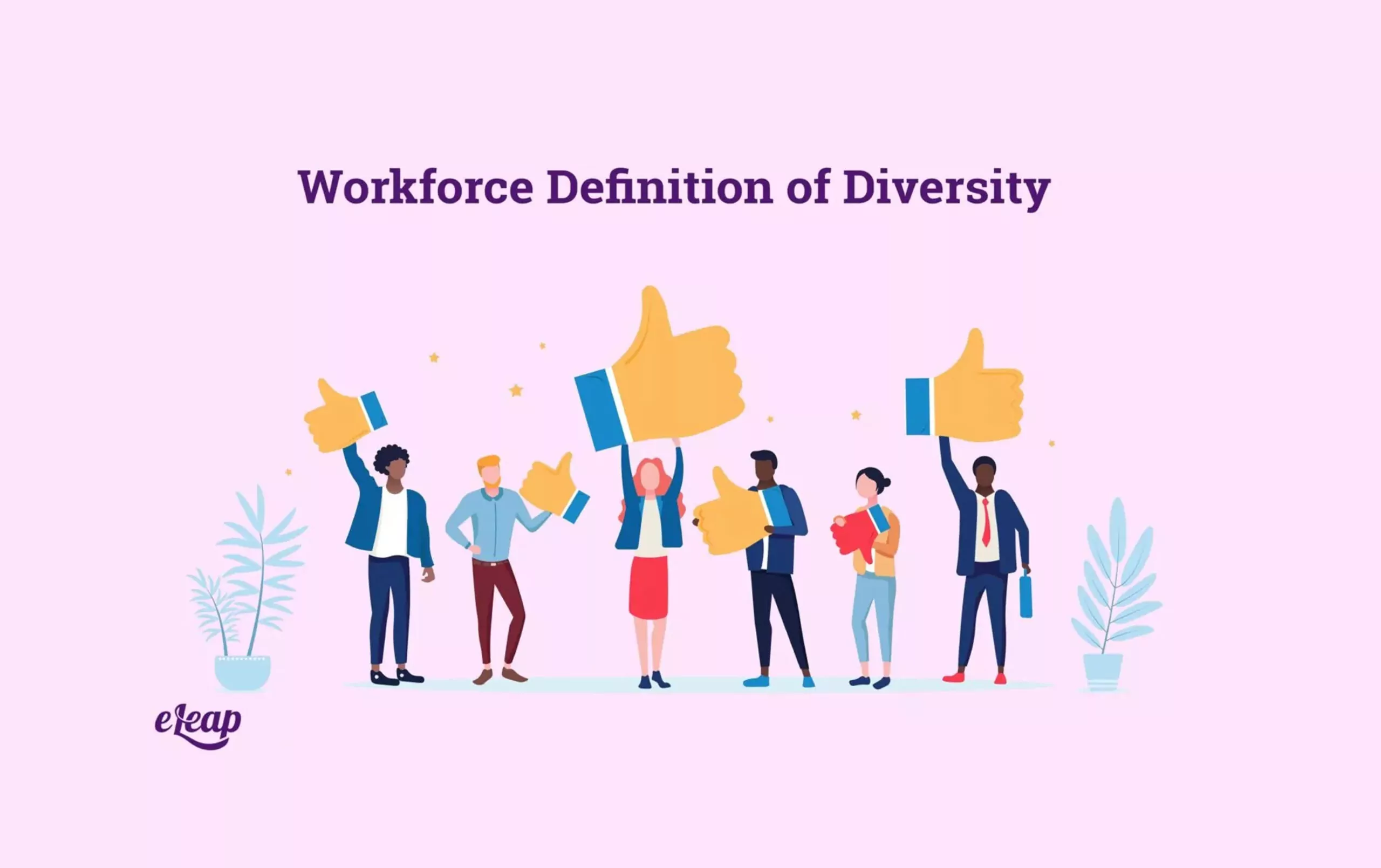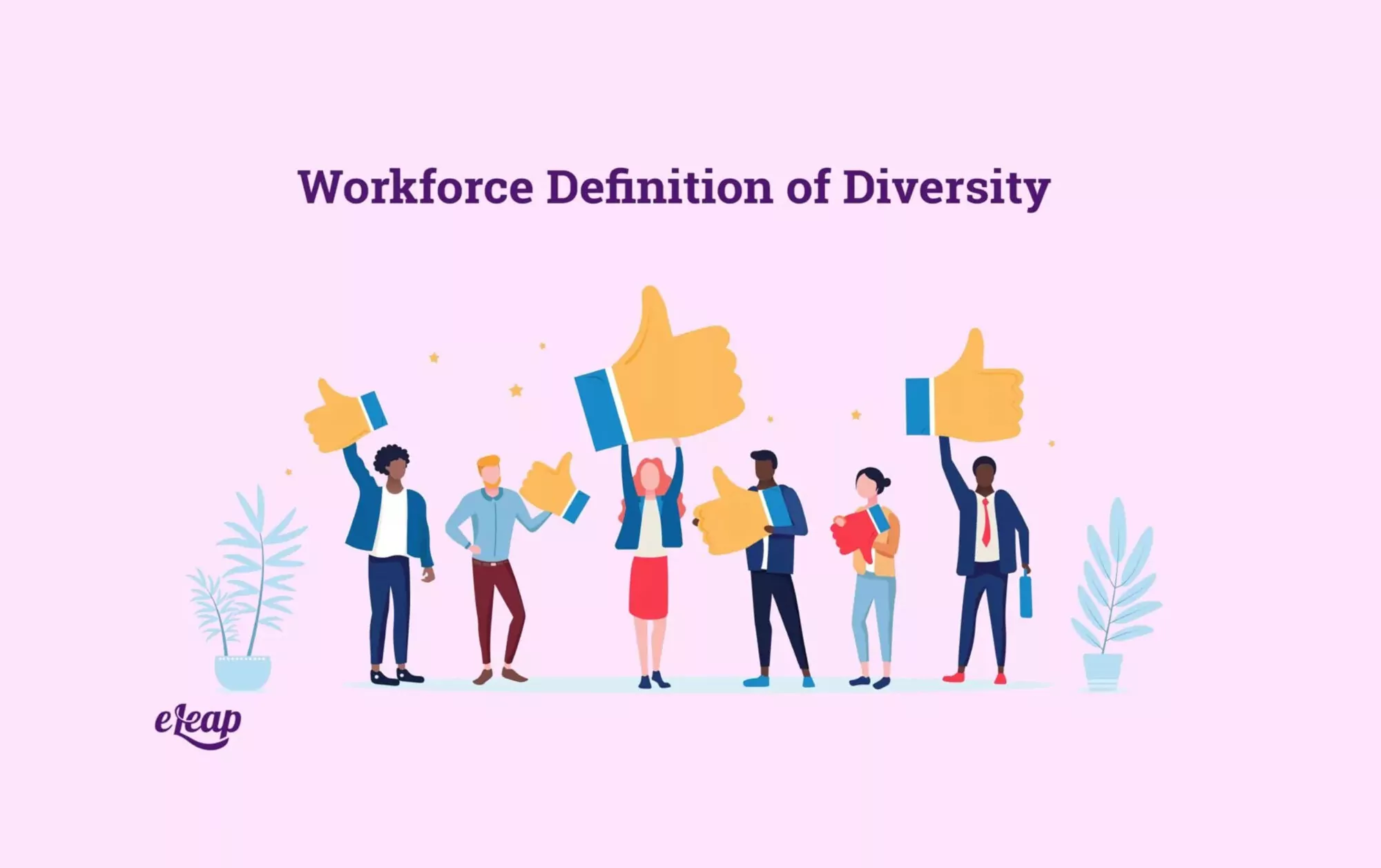Workforce Definition of Diversity

The discussion of diversity, especially in the workplace, as well as the workforce definition of diversity, is a hot topic in the human resource industry. Employees are not only eager to make a change toward a more diverse and inclusive but to carve out their workforce definition of diversity as well. Employers are giving diversity, equality, and inclusion, otherwise known as DEI programs, a higher priority than ever and allocating resources to ensure that their teams are prepared for success. Focusing on DEI is the right thing to do as a person, for humanity, as well as the wise thing to do for your business.
Continue reading to learn more about the advantages and disadvantages of workplace diversity. In an effort to work toward a united front, there are a few steps you can take to help you get there.
What Is Your Workforce Definition of Diversity?
An organization that consciously hires a staff made up of people with a variety of traits, such as gender, religion, race, age, ethnicity, sexual orientation, education, and other attributes, is said to practice diversity in the workplace.
There are numerous advantages to diversity in the workplace, both within and externally. But that doesn’t imply that putting diversity efforts into practice at work doesn’t provide its own set of difficulties. It’s essential to understand both sides of the matter in order to create a plan that works for all in a respectful and efficient manner.
Advantages of Diversity at Work
When you encourage fresh viewpoints in creating your workforce definition of diversity, you bring a varied range of viewpoints. Hiring people of different ages, nationalities, and cultures allows your business the opportunity to grow and thrive in this new diverse world. Benefits like improved problem solving and more productivity may result from embracing changes.
Some of your managers may find it intimidating to consider bringing in fresh viewpoints. They may worry about unpleasant situations or the introduction of unfavorable ideas. They may even struggle with their own thoughts when it comes to diversity and whether it aligns with the company’s workforce definition of diversity. Allowing team members to work through these issues is key, as well as providing education along the way.
By focusing on your workforce definition of diversity, as well as providing a safe environment for development, you are widening your possible span of talent. Employees are seeking an environment in which they may develop, feel valued, and face challenges. Because of this, a business that values diversity will draw a larger spectrum of applicants seeking a progressive workplace.
This search for a different work environment began before the pandemic, but workplace shutdowns and remote work increased the need for change as employees began to see everything in a different light.

It goes without saying that a business that actively pursues people who are diverse will have access to a larger talent pool. Even while you should always be picky when it comes to hiring, being overly particular about qualities that don’t matter can drastically reduce the pool of candidates you can even consider. To identify quality hires, it is important to embrace a variety of backgrounds, thoughts, ethnicities, and other aspects. You may even find that you are looking outside your normal boundaries to get the best possible options.
An increase in creation and innovation is another advantage of diversity in the workplace. When you consider it, the connection makes sense. If a group of people is homogeneous, then it is likely that everything about them, including their mental processes, life experiences, and problem-solving techniques, will be similar. Additionally, sameness does not produce original solutions. On the other hand, a diverse workforce will provide special viewpoints that may result in intellectual breakthroughs.
The same rationale underlies why crucial strategy meetings are held offsite by businesses, as well as how a change of scenery can spur creative problem-solving. Fresh ideas are known to be inspired by novel situations and locations. According to a recent study, businesses that demonstrate a strong commitment to diversity tend to be substantially more inventive.
Inclusion and diversity go hand in hand. Employees feel more comfortable being themselves in a work setting when they witness the representation of a range of ethnicities, backgrounds, and thought processes. Employees are happier and more productive as a result.
However, studies have shown that the drive to fit in within a strong, homogenous culture can suppress natural cognitive variety. Employees are more prone to fear rejection and perform subpar work if they don’t feel free to be themselves at work.
Creating a Workforce Definition of Diversity Isn’t Always Easy
Diversity in the workplace requires a significant investment, and there is no manual from which you can carve your path. Each business and team is different, which is why it is essential that your core group creates your workforce definition of diversity together. Your diversity policies must be in line with business goals if you want to be successful. Every firm has different goals. This entails determining your goals while taking into account the particular culture you currently have in place.
Don’t feel compelled to simply copy and paste the projects that the businesses nearby are pursuing. For instance, if your workforce is already diverse in terms of race, does it make sense to focus your entire purpose on increasing those numbers just because other businesses are doing so? Maybe you should concentrate on intersectionality next so that other areas of diversity can be driven by your current strengths. Keeping up with competitors can be a downfall if you’re not careful.
Consider conducting a diversity-focused survey to uncover the precise gaps in your organization so you can direct your resources there. Otherwise, you risk making incorrect assumptions and wasting your time on projects that won’t really make a difference.
The most careful and meticulous diversity program can be created when you take your time and thoroughly look at all angles. But if no one is available to carry them out, all your efforts will be in vain. Because of this, you must ensure that you have the personnel, resources, and support needed to move your diversity initiatives from conception to implementation. Make sure your team is on board and prepared to take action, and secure leadership backing so you can move forward with confidence.
Diversity doesn’t happen in bits and pieces, although it may start in small segments. For it to be successful, the entire organization must work together. Managers, in particular, have a significant impact on how these activities are carried out. To help managers comprehend the diversity goals of the organization, it’s important to understand a few things.
- Why they are significant?
- What is expected of them?
- When to engage employees.
It is crucial to invest in management training. Microaggressions, insensitive behavior, and exclusionary attitudes can all be displayed by one person without negatively affecting the company’s culture or an employee’s experience.
People have biases. The great majority of decisions made by people are based on biases, opinions, and intuition rather than facts or reasoning. This does not mean change will fail before it even starts. It does mean that some changes may take time. The important thing is to not give up.
It is essential that businesses not only provide diversity training but also focus on training to reduce bias. Even while bias will inevitably exist in the workplace, it makes a significant difference to at least be aware of them and have a basic understanding of how to prevent or resolve them.
Unfortunately, not everyone agrees with the concept of workplace diversity. Some people simply find the unfamiliar unsettling. and they ultimately get used to it. Others, however, can be vehemently opposed to the notion of purposefully fostering diversity in the workplace.
No matter the reason for the internal opposition, it’s crucial that you and your management team make an effort to consistently educate your staff about the why behind your diversity efforts.
Internal opposition might be difficult to overcome, but it’s crucial to keep in mind that the goal of effective diversity and inclusion is to lead individuals toward understanding. This calls for emphasizing those who do not comprehend its significance as well as those who do.
If you make it apparent what company culture stands for, some employees may finally recognize that it’s not the appropriate place for them and choose to quit. This is not meant to imply that they are excluded, but rather that individuals are aware when their beliefs differ from those of the organization as a whole.
Implementation of Your Workforce Definition of Diversity
The best method to hold the company responsible for performance is to have a dedicated resource, such as a Head of Diversity and Inclusion. You can also create an Inclusion and Diversity council of essential team members.
This council can assist in the creation of the workforce definition of diversity, meet on certain matters, and help put the plan into practice. This council should be diverse in its makeup and understand the overall goal.
Once you’ve developed your definition and plan, you can move forward with the council toward a more diverse future.